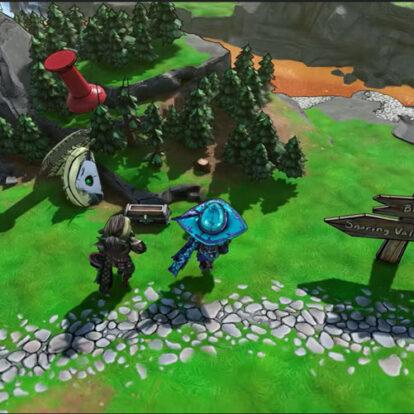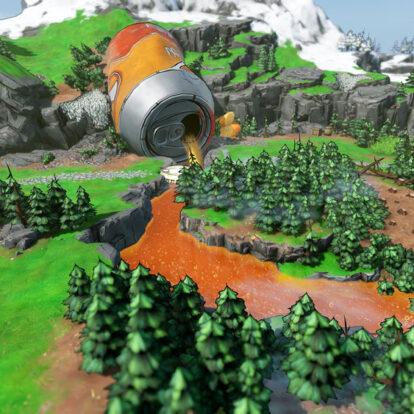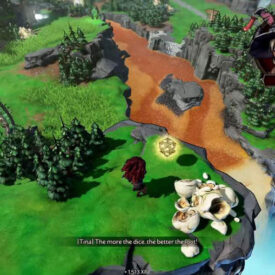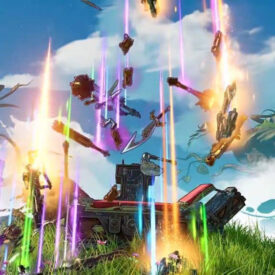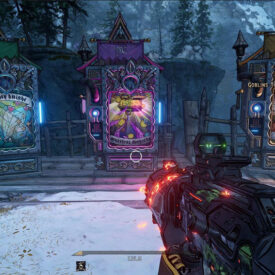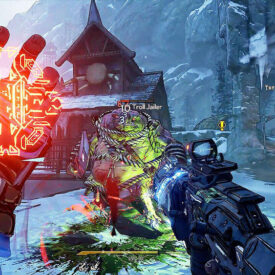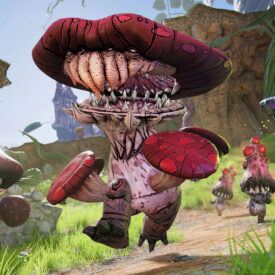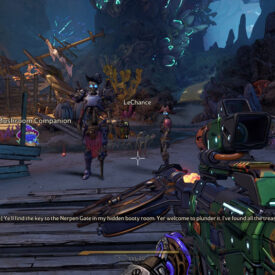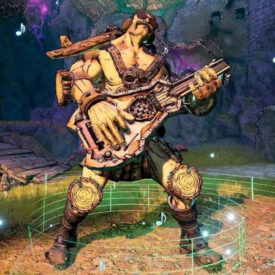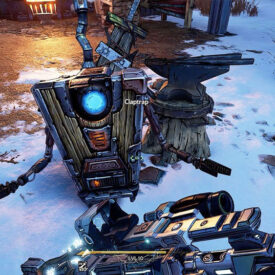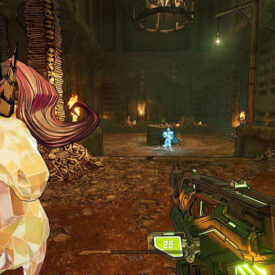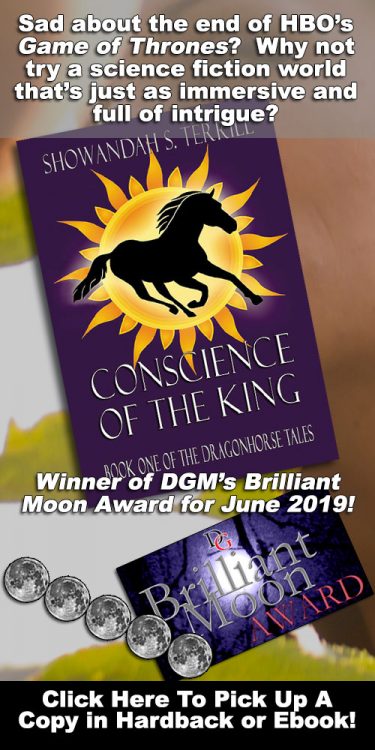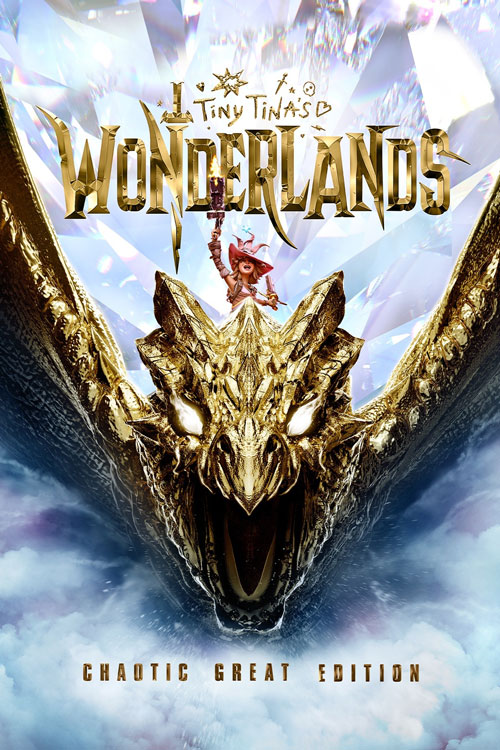 Developer: 2K Games
Developer: 2K Games
Distributor: Gearbox Games
Genre: RPG/Fantasy/Shooter
Unique Elements: Hilarious, but mentally unbalanced child, Tiny Tina, returns as the the dungeon master for Bunkers & Badasses, a crazy RPG set in the Borderlands universe.
Series: Borderlands
Systems: PS4, PS5, Xbox One
Release Date: March 25, 2022
Estimated Play Length: 30-60 hours
MSRP: $59.99 regular; $79.99 Chaotic Great Addition
Website: https://playwonderlands.2k.com/
Trailer/Video: https://youtu.be/3gJgj2ngCyA
Purchase Site: https://amzn.to/3I3VHyT
Reviewed by: JT Hanke
Final Score: 4.5 Moons (out of 5)
What happens when you allow Tiny Tina to take over an entire video game? Come with me and find out as we look at Tiny Tina’s Wonderlands (TTW)!
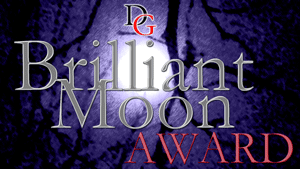
You play the Newbie, a character that has crash landed in Borderlands along with your shipmates, human pilot Valentine, played by Andy Samberg from SNL/Lonely Island, and self-absorbed robot Frette, who is voiced by consummate comedienne Wanda Sykes. While your ship is being repaired, Tiny Tina approaches you and asks you to play her favorite game, Bunkers & Badasses. When you all agree, she takes over as Bunkermaster and tells you a terrifying tale of the Dragon Lord who you must find and vanquish in aid to Queen Buttstallion–a diamond bi-corn (because she’s too badass to be just a unicorn) that rules the kingdom.
Presentation
The last two installments of Borderlands–Borderlands: The Pre-Sequel (BL:PS) and Borderlands 3 (BL3)–have suffered quite a bit for me. Both have a bizarre Handsome Jack-shaped hole—which is odd because BL:PS is all about Handsome Jack (played by Dameon Clarke), but it’s a Handsome Jack that is an anti-hero ally rather than a villainous antagonist. Handsome Jack simply works best as a bad guy and, with his inclusion and the lead writing of Anthony Burch (the brother of the voice actress who plays Tiny Tina, Ashly Burch), Borderlands 2 (BL2) was the Black album of the Borderlands franchise, in my opinion.
While Tiny Tina’s Wonderlands is still devoid of Handsome Jack, it’s packed full of my favorite character from BL2: Tiny Tina. Arguably the best expansion for Borderlands 2 was the Tiny Tina rpg DLC, Tiny Tina’s Assault on Dragon’s Keep. Director Matt Cox decided to lead us into a full RPG based around Tina’s decidedly inappropriate humor and her favorite RPG, Bunkers & Badasses.
With that said, due to the fact that this was made into a T for Teen game for a decidedly R rated character, it’s a little like when they recut Deadpool 2 to PG-13 and blended it with The Princess Bride. You don’t get as much raunchy humor as you’ve come to expect from Ashly Burch’s Tiny Tina, but it’s still surprisingly funny and engaging.
Along with Tina as the bunkermaster, your antagonist, in lieu of a Handsome Jack foil, is The Dragon Lord played by Will Arnett (from Arrested Development and Lego Batman), whose portrayal has a lot of Handsome-Jack-isms about it.
You can still feel the absence of Anthony Burch‘s writing in both BL3 and TTW, but the writing is definitely much more engaging in TTW, for the most part, than in BL3, which could become a bit of a slog.
While I was at first disappointed to find that everyone’s favorite explosive hype man, Mr. Torgue, isn’t helping Tina directly lead the game (the way he was in the DLC of BL2), he does show up as a heavy metal bard in a way that is truly incredible. Although he doesn’t feature nearly as prominently in this game as I wish he did, he’s still a welcome inclusion in TTW—especially when he attempts to blow up the ocean! (“Can someone say ‘splosions?!?“)
Much like Shrek, there are lots of fantasy and fairy tale tropes for Tina to poke fun of, including Jack and the Bean Stalk (which always has a strange parody of Kenny G music playing as background music while you’re in its levels), cyclops, goblins, a plethora of Wyverns (which are pronounced “WHY-verns” and never to be pronounced any other way, according to Tina), and a send up of the Smurfs called the Murphs. For those of you who love The Witcher‘s Geralt of Rivia, you’ll get a full set of quests with Gerritt of Trivia, the Ditcher. Taking Geralt’s terseness to a humorous level, Garritt is just a straight up dick. (Although, just like the actual Witcher, the character does grow on you. Unfortunately, they didn’t get Henry Cavill to voice him from the Netflix series or Doug Cockle from the video games, which would’ve been cool. John Gremillion, though, did a nice take as the voice of Gerritt.)
When you finally get to it, the ending is amusing and actually has some heart to it. Without giving anything away, it sort of reminded me of an ending to one of the Toy Story movies—which I mean in a truly good way.
The only downside with the ending is how the end credits work. Just like in past games, after you complete the final boss battle, it goes to an end credit roll before you can finalize the last few things and pick up all your loot from this playthrough. What was different here is the end credit sequence feels like it’s longer than all of the Borderlands games put together. (Like I went and fixed an omelette and I wasn’t even partway through when I got done.) You can’t click any buttons to skip it and the only “trick” I found is that if you hold digital down it takes the speed of the scroll up by 3x. (Don’t get me wrong, the folks who made this game had to do almost of all of it during quarantine in the pandemic, and they wanted their notes to be read, but you still need to give people an option to skip the credits at least around the time a mid-credits scene might appear in a film.)
Gameplay
For those new to the Borderlands games, they are a cell-shaded first person shooter that relies on a lot of hyper-violence and salty language while you try to accomplish your missions. One of the biggest things about the game series is how it randomizes loot so that you will ALMOST never pick up the same loot twice (outside of a single repeatable glitch that I noted with picking up “forgotten” loot left in opened treasure chests where you end up receiving two of these items, but I’m sure that’ll be patched shortly). This means that every playthrough will yield weapons, shields, and other loot with completely different combinations of abilities—even on “named” boss loot. TTW just takes all of that fun and puts it in a fantasy world.
The plethora of guns from Borderlands is back, with some fun fantasy twists. Many shotguns fire waves of magic, while Feriore (which replace Tediore) guns will transform when you go to swap out their ammo. Unlike in past games, where these guns would usually just turn into grenades when thrown, in TTW they’ll transition into three headed hydras, machine gun pixies, dagger storms, bolts of lightning, and even pterodactyl-like flying guns.
To get you between traditional Borderlands-style levels of mayhem, you’ll have to use the Overland Map which is a Tiny-Tina-constructed miniature map where your animated miniature can explore. The Overland is full of monsters that can attack out of the grass, special mission givers, shortcuts to smash open, chests to loot, and special 20-sided dice that will give you loads of cash. (And because Tina made it herself, it incorporates things like soda cans, bottle caps, Cheetos, and other anachronistic building materials.)
Beyond the main story missions, there are tons of mini-missions and side quests for the completionist, which weave in still more fairy tale cameos and callouts, and, don’t worry, our good friend Clap-Trap will have a couple suitably silly missions for you to help with, as well.
One improvement in TTW that I didn’t see in BL3 is the fact that all areas and monsters auto-level to give you a challenge, so you’re not running into level 10 monsters when you’re level 30. (I remember playing one of the DLC expansions in BL2 in the wrong order of game play and had it be way too easy and boring with no way to readjust the difficulty level.) This also means that you’re picking up loot that is the right level for you, which is really cool. (Now, it’s much less common for you to pick up something that’s too high a level for you. In fact, in my play through, I don’t think I ran into loot that was too powerful more than a handful of times.)
The only thing missing was a card-based mini-game to fill in for playing a game of Magic: the Gathering in-between D&D–I mean, B&B–campaigns.
You have a lot more customization in this game than in past games because, like many role playing games, you can have both a primary ability set and a secondary ability set. This gives a decidedly Elder Scrolls feel to it at the cost of some of the uniqueness we’ve come to expect from having individual pre-built characters as protagonists rather than self-built characters.
With that said, the choices you can make, while huge by Borderlands standards, are pretty small compared to something like Skyrim. (Like you can choose your gender, hair style, makeup, and basic outfits, but you can’t change your body type or build. On the plus side, you can always change out what you’re wearing at a quick change shop if you don’t like how you look to others.) However, unlike Skyrim, which tends to not allow you to unlock other makeup or style options, TTW will let you unlock more and more costume, makeup, and banner components as dropped loot. (And, if you already have unlocked one of these pieces, it’ll alert you to that and then you can sell it for big stacks of cash.)
When you initially start, you can choose a primary class to be (six of which are included with the default edition, while Blightcaller is included in season pass or the Chaotic Great edition):
- Blightcaller* – This shamanic Elementalist channels spirits and summons storms to wear down foes with poison and elemental damage.
- Brr-Zerker – Tenacious frost-infused bruisers who complement their firepower with an onslaught of brutal melee attacks.
- Clawbringer – Faithful warriors who bring down thunder and flames upon their enemies with a spectral hammer and their fire-breathing Wyvern Companion.
- Graveborn – Death-touched acolytes who sacrifice health to unleash deevastating Dark Magic attacks and become the phantasmal Reaper of Bones, accompanied by their manic Demi-Lich companion.
- Spellshot – Gun-toting wizards who can unleash a constant barrage of spells and bullets and transform their enemies into harmless livestock with the snap of a finger.
- Spore Warden – masters of nature who summon tornadoes and launch volleys of arcane arrows into enemy lines alongside their toxin-spewing Mushroom companion.
- Stabbomancer – sneaky, critical-hit-focused assassins who summon magic whirling blades and disappear into the shadows at will.
Once you play for awhile, you’ll be able to choose a secondary class. Technically, according to the website, all of these combos have their own cool names like Hammerzerker or Blightgeist, but I never heard them used in the actual game and there is no real organic interaction between the different classes. It’s just like having the abilities of two different characters that you can upgrade, but you can only choose one super move at a time. I was actually fairly disappointed that they didn’t have a way to have a cross-over super move between two chosen classes, as that would have added a lot of intrinsic reason to have two classes—as opposed to feeling like RPG fan-service that wasn’t properly woven into the game. (Once you beat the game itself, they allow you to swap out your classes as you choose, which is cool.)
The Borderlands franchise has been moving farther and farther away from local co-op, which is really sad, since Borderlands 2 had some of the best co-op out there and supported four player! In the last few games they’ve restricted it to local two player, but, in TTW, the local two player kind of sucks.
As they’ve gotten into more and more powerful video game systems, Borderlands games have pushed into tinier and tinier fonts, making it hard to read titles in co-op Borderlands 3, and then, in this new game, in co-op, they got rid of the titles for the guns and gear entirely after you pick them up (even if you’re playing on very large screens) and they’ve shortened status effects to symbols (but there are too many symbols to readily remember). The only workaround that I found was to read all info on a gun before you pick it up (but you can’t mark it for trash before you pick it up) OR, once it’s in your inventory, use the “R3” command to do an in-depth look. Both of these solutions really do a number on ease of play and length of time to actually play things.
With that said, it’s not all bad news in co-op. They now have completely separate loot drops and loot caches in co-op, so you’re not fighting for loot. You can still trade things, so you sort of get the best of both worlds from the past and present games—other than that reading titles issue I mentioned before!
Audience Fit
This is a great take on a paper RPG for digital with a huge amount of dark humor. Yes some of the sharp edges are polished off due to the T for Teen rating, but most of what you loved about Tiny Tina in BL2 is still alive and well.
Closing Thoughts
Is it as good as Borderlands 2? No. However, I think Tiny Tina’s Wonderlands may in fact be my second favorite game in the Borderlands series, which is high praise as I’ve liked all of the Borderlands games. I would highly recommend you pick up a copy and check it out.
Presentation: 5.0 Moons (out of 5)
Gameplay: 4.0 Moons (out of 5)
Gothic Fit: 4.5 Moons (out of 5)
Final Score (not an average): 4.5 Moons (out of 5)
![]()

